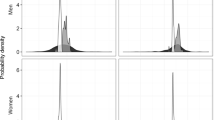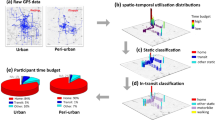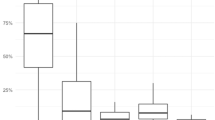Abstract
Personal exposure to air pollution is associated with time- and location-specific factors including indoor and outdoor air pollution, meteorology and time activities. Our investigation aims at the description and identification of factors determining personal exposure to particle number concentration (PNC) in everyday situations. Ten volunteers recorded their personal exposure to PNC and kept an activity diary in three different seasons besides stationary measurements of ambient air pollution and meteorology. Background exposure to PNC was modelled using the most predictive variables. In a second step, the effects of the activities were calculated adjusted for the background exposure. The average personal PNC level was highest in winter and was three times higher than the mean stationary PNC level while staying indoors and two times higher while staying outdoors. Personal indoor PNC levels were significantly increased during the use of candles, cooking and the occurrence of smell of food. High stationary outdoor PNC levels and low dew point temperatures were associated with increased personal outdoor PNC levels. Times spent in public transport were associated with lower personal PNC levels than other times spent in transportation. Personal PNC levels in everyday situations exhibited a large variability because of seasonal, microenvironment-specific and activity-specific influences.
This is a preview of subscription content, access via your institution
Access options
Subscribe to this journal
Receive 6 print issues and online access
$259.00 per year
only $43.17 per issue
Buy this article
- Purchase on Springer Link
- Instant access to full article PDF
Prices may be subject to local taxes which are calculated during checkout



Similar content being viewed by others
References
Brook R, Rajagopalan S, Pope C, III, Brook J, Bhatnagar A, Diez-Roux A et al. Particulate matter air pollution and cardiovascular disease. Circulation 2010; 121: 2331–2378.
Rückerl R, Schneider A, Breitner S, Cyrys J, Peters A. . Health effects of particulate air pollution: A review of epidemiological evidence. Inhal Toxicol 2011; 23: 555–592.
Pope CA, 3rd, Dockery D . Health effects of fine particulate air pollution: lines that connect. J Air Waste Manag Assoc 2006; 56: 709–742
Peters A, Rückerl R, Cyrys J . Lessons from air pollution epidemiology for studies of engineered nanomaterials. Occup Environ Med 2011; 53: S8–S13.
Heyder JJ, Gebhart J, Rudolf G, Schiller CF, Stahlhofen W . Deposition of particles in the human respiratory tract in the size range 0.005–15 μm. J Aerosol Sci 1986; 17: 811–825.
Oberdörster G, Oberdörster E, Oberdörster J . Nanotoxicology: an emerging discipline evolving from studies of ultrafine particles. Environ Health Persp 2005; 113: 823–839.
Wilson WE, Brauer M . Estimation of ambient and non-ambient components of particulate matter exposure from a personal monitoring panel study. J Expo Sci Environ Epidemiol 2006; 16: 264–274.
Wehner B, Wiedensohler A . Long term measurements of submicrometer urban aerosols: statistical analysis for correlations with meteorological conditions and trace gases. Atmos Chem Phys 2003; 3: 867–879.
Lonati G, Giugliano M . Size distribution of atmospheric particulate matter at traffic exposed sites in the urban area of Milan (Italy). Atmos Environ 2006; 40: S264–S274.
Hussein T, Puustinen A, Aalto P, Mäkelä J, Hämeri K, Kulmala M . Urban aerosol number size distributions. Atmos Chem Phys 2004; 4: 391–411.
Gómez-Moreno F, Pujadas M, Plaza J, Rodríguez-Maroto J, Martínez-Lozano P, Artíñano B. . Influence of seasonal factors on the atmospheric particle number concentration and size distribution in Madrid. Atmos Environ 2011; 45: 3169–3180.
Pitz M, Cyrys J, Karg E, Wiedensohler A, Wichmann H, Heinrich J . Variability of apparent particle density of an urban aerosol. Environ Sci Technol 2003; 37: 4336–4342.
Krudysz M, Moore K, Geller M, Sioutas C, Froines J . Intra-community spatial variability of particulate matter size distributions in Southern California/Los Angeles. Atmos Chem Phys 2009; 9: 1061–1075.
Ruuskanen J, Tuch T, Ten Brink H, Peters A, Khlystov A, Mirme A et al. Concentrations of ultrafine, fine and PM2.5 particles in three European cities. Atmos Environ 2001; 35: 3729–3738.
Berghmans P, Bleux N, Int Panis L, Mishra VK, Torfs R, Van Poppel M . Exposure assessment of a cyclist to PM10 and ultrafine particles. Sci Total Environ 2009; 407: 1286–1298.
Cattaneo A, Garramone G, Taronna M, Peruzzuo C, Cavallo DM . Personal exposure to airborne ultrafine particles in the urban area of Milan. J Phys. Conference Series 2009; 151: 012039.
Sturm PJ, Baltensperger U, Bacher M, Lechner B, Hausberger S, Heiden B et al. Roadside measurements of particulate matter size distribution. Atmos Environ 2003; 37: 5273–5281.
Zhu Y, Hinds WC, Kim S, Sioutas C . Concentration and size distribution of ultrafine particles near a major highway. J Air Waste Ma 2002; 52: 1032–1042.
Cyrys J, Pitz M, Heinrich J, Wichmann H, Peters A . Spatial and temporal variation of aerosol number concentration in Augsburg, Germany. Sci Total Environ 2008; 401: 168–175.
Moschandreas DJ . Exposure to pollutants and daily time budgets of people. Bull N Y Acad Med 1981; 57: 845–859.
Cohen Hubal E, Sheldon L, Burke J, McCurdy T, Berry M, Rigas ZV et al. Children’s exposure assessment: a review of factors influencing children’s exposure, and the data available to characterize and assess that exposure. Environ Health Persp 2000; 108: 475–486.
Brasche S, Bischof W . Daily time spent indoors in German homes – Baseline data for the assessment of indoor exposure of German occupants. Int J Hyg Environ Health 2005; 208: 247–253.
Franck U, Herbarth O, Wehner B, Wiedensohler A, Manjarrez M . How do the indoor size distributions of airborne submicron and ultrafine particles in the absence of significant indoor sources depend on outdoor distributions? Indoor Air 2003; 13: 174–181.
Morawska L, He C, Hitchins J, Mengersen K, Gilbert D . Characteristics of particle number and mass concentrations in residential houses in Brisbane, Australia. Atmos Environ 2003; 37: 4195–4203.
He C, Morawska L, Hitchins J, Gilbert D . Contribution from indoor sources to particle number and mass concentrations in residential houses. Atmos Environ 2004; 38: 3405–3415.
Bekö G, Weschler CJ, Wierzbicka A, Karottki DG, Toftum J, Loft S et al. Ultrafine particles: Exposure and source apportionment in 56 Danish homes. Environ Sci Technol 2013; 47: 10240–10248.
Hampel R, Breitner S, Schneider A, Zareba W, Kraus U, Cyrys J et al. Acute air pollution effects on heart rate variability are modified by SNPs involved in cardiac rhythm in individuals with diabetes or impaired glucose tolerance. Environ Res 2012; 112: 177–185.
Hampel R, Breitner S, Zareba W, Kraus U, Pitz M, Geruschkat U et al. Immediate ozone effects on heart rate and repolarisation parameters in potentially susceptible individuals. Occup Environ Med 2012; 69: 428–436.
Peters A, Hampel R, Cyrys J, Belcredi P, Geruschkat U, Breitner S et al. Ultrafine particles induce immediate changes in heart rate variability in patients with diabetes. In: 50th Cardiovascular Disease Epidemiology and Prevention Annual Conference, 2–4 March 2010, San Francisco, CA. Dallas, TX:American Heart Association, 94. 2010. Available http://my.americanheart.org/idc/groups/ahaecc-internal/@wcm/@sop/documents/downloadable/ucm_323837.pdf (accessed 4 November 2013).
Rückerl R, Hampel R, Breitner S, Cyrys J, Kraus U, Carter J et al. Associations between ambient air pollution and blood markers of inflammation and coagulation/fibrinolysis in susceptible populations. Environ Int 2014; 70: 32–49.
Pitz M, Birmili W, Schmid O, Peters A, Wichmann H, Cyrys J . Quality control and quality assurance for particle size distribution measurements at an urban monitoring station in Augsburg, Germany. J Environ Monitor 2008; 10: 1017–1024.
Bühlmann P, Hothorn T . Boosting algorithms: Regularization, prediction and model fitting. Stat Sci 2007; 22: 477–505.
Pinheiro JC, Bates DM . Mixed-Effects Models in S and S-PLUS. Springer: New York. 2000.
Fromme H, Twardella D, Dietrich S, Heitmann D, Schierl R, Liebl B et al. Particulate matter in the indoor air of classrooms - exploratory results from Munich and surrounding area. Atmos Environ 2007; 41: 854–866.
Pekkanen J, Timonen K, Ruuskanen J, Reponen A, Mirme A . Effects of ultrafine and fine particles in urban air on peak expiratory flow among children with asthmatic symptoms. Environ Res 1997; 74: 24–33.
Penttinen P, Timonen K, Tiittanen P, Mirme A, Ruuskanen J, Pekkanen J . Number concentration and size of particles in urban air: effects on spirometric lung function in adult asthmatic subjects. Environ Health Persp 2001; 109: 319–323.
Wallace L, Ott W . Personal exposure to ultrafine particles. J Expo Sci Environ Epidemiol 2011; 21: 20–30.
Buonanno G, Marini S, Morawska L, Fuoco FC . Individual dose and exposure of Italian children to ultrafine particles. Sci Total Environ 2012; 438: 271–277.
Wheeler AJ, Wallace LA, Kearney J, Van Ryswyk K, You H, Kulka R et al. Personal, indoor, and outdoor concentrations of fine and ultrafine particles using continuous monitors in multiple residences. Aerosol Sci and Technol 2011; 45: 1078–1089.
Kearney J, Wallace L, MacNeill M, Xu X, VanRyswyk K, You H et al. Residential indoor and outdoor ultrafine particles in Windsor, ON. Atmos Environ 2011; 45: 7583–7593.
Brauer M, Hirtle R, Hall A, Yip T . Monitoring personal fine particle exposure with a particle counter. J Exposure Anal Environ Epidemiol 1999; 9: 228–236.
Kaur S, Nieuwenhuijsen J . Determinants of personal exposure to PM2.5, ultrafine particle counts, and CO in transport microenvironment. Environ Sci Technol 2009; 43: 4737–4743.
Acknowledgements
This research has been funded in part by the United States Environmental Protection Agency through STAR (Science to Achieve Results) grant RD 832415 to the University of Rochester. It has not been subjected to the Agency’s required peer and policy review and therefore does not necessarily reflect the views of the Agency and no official endorsement should be inferred. The KORA research platform (KORA, Cooperative Health Research in the Region of Augsburg) and the MONICA Augsburg studies were initiated and financed by the Helmholtz Zentrum München, German Research Centre for Environmental Health (formerly GSF, National Research Centre for Environment and Health), which is funded by the German Federal Ministry of Education and Research and by the State of Bavaria. Data collection for the validation study of the Augsburger Umweltstudie as well as the contributions of Susanne Breitner, Veronika Deffner and Verena Maier have been funded by the German Research Foundation (DFG grant number KU1359/2-1).
Author information
Authors and Affiliations
Corresponding author
Ethics declarations
Competing interests
The authors declare no conflict of interest.
Additional information
Supplementary Information accompanies the paper on the Journal of Exposure Science and Environmental Epidemiology website
Supplementary information
Rights and permissions
About this article
Cite this article
Deffner, V., Küchenhoff, H., Maier, V. et al. Personal exposure to ultrafine particles: Two-level statistical modeling of background exposure and time-activity patterns during three seasons. J Expo Sci Environ Epidemiol 26, 17–25 (2016). https://doi.org/10.1038/jes.2014.73
Received:
Revised:
Accepted:
Published:
Issue Date:
DOI: https://doi.org/10.1038/jes.2014.73
Keywords
This article is cited by
-
Distributions and determinants of time spent outdoors among school-age children in China
Journal of Exposure Science & Environmental Epidemiology (2022)
-
Personal exposure to particulate matter in peri-urban India: predictors and association with ambient concentration at residence
Journal of Exposure Science & Environmental Epidemiology (2020)
-
Perceptions and experiences of outdoor occupational workers using digital devices for geospatial biometeorological monitoring
International Journal of Biometeorology (2020)
-
Mobility assessment of a rural population in the Netherlands using GPS measurements
International Journal of Health Geographics (2017)
-
Outdoor ultrafine particle concentrations in front of fast food restaurants
Journal of Exposure Science & Environmental Epidemiology (2016)



